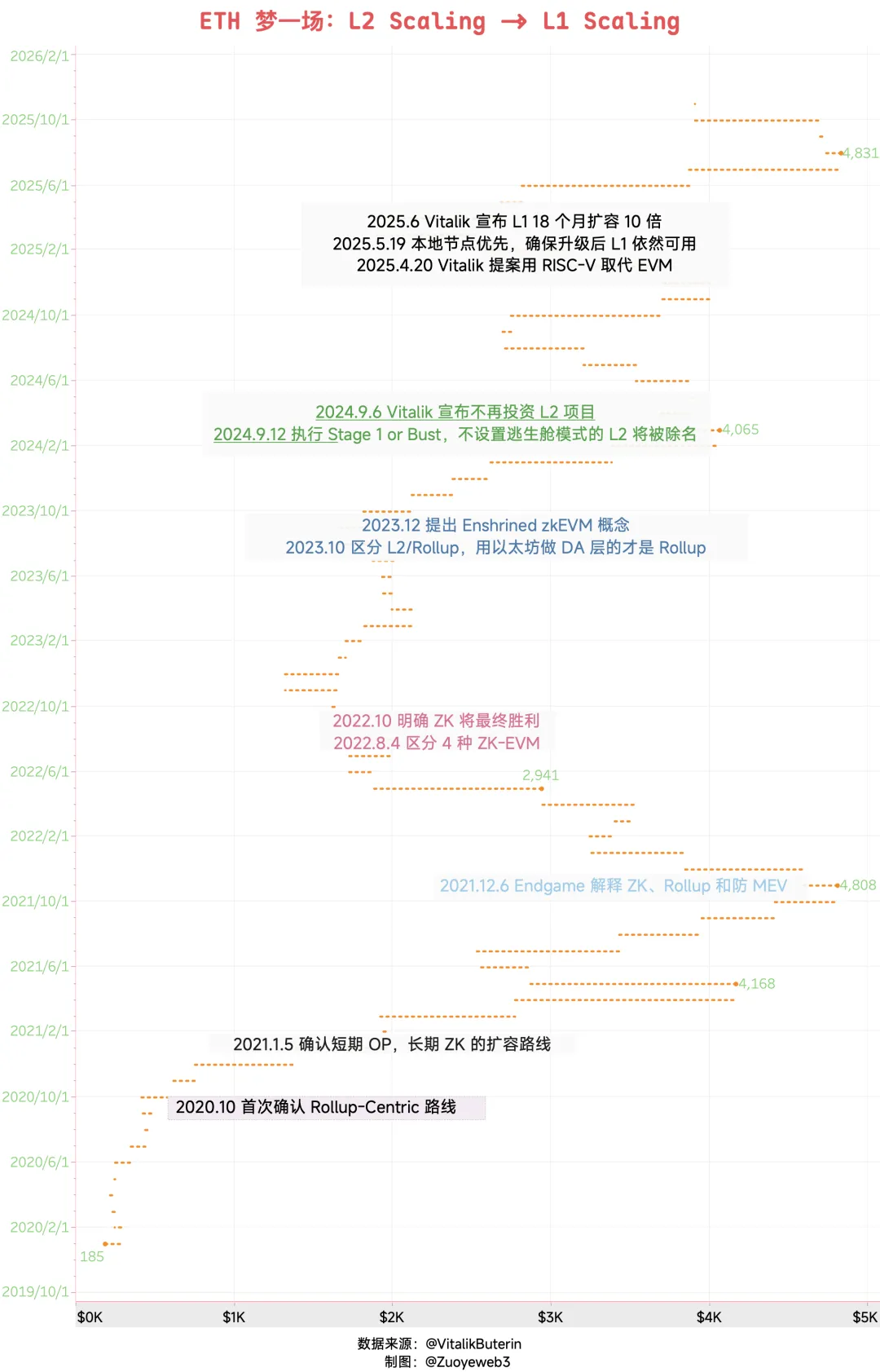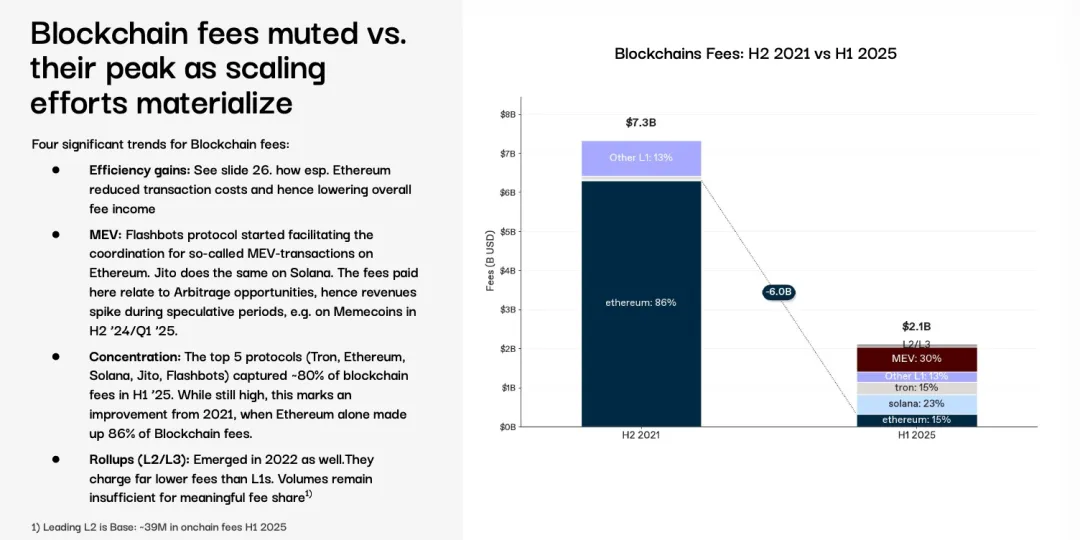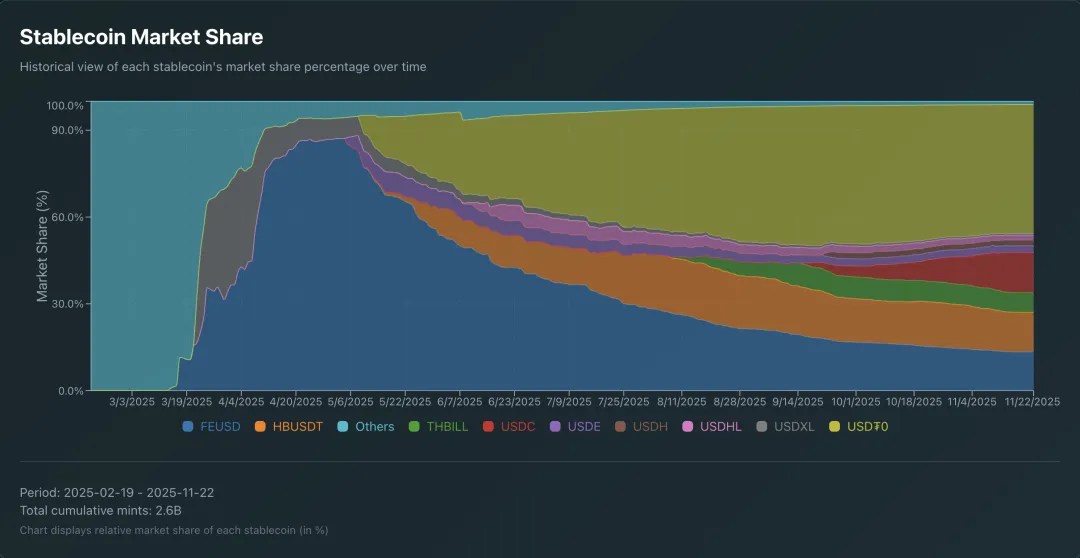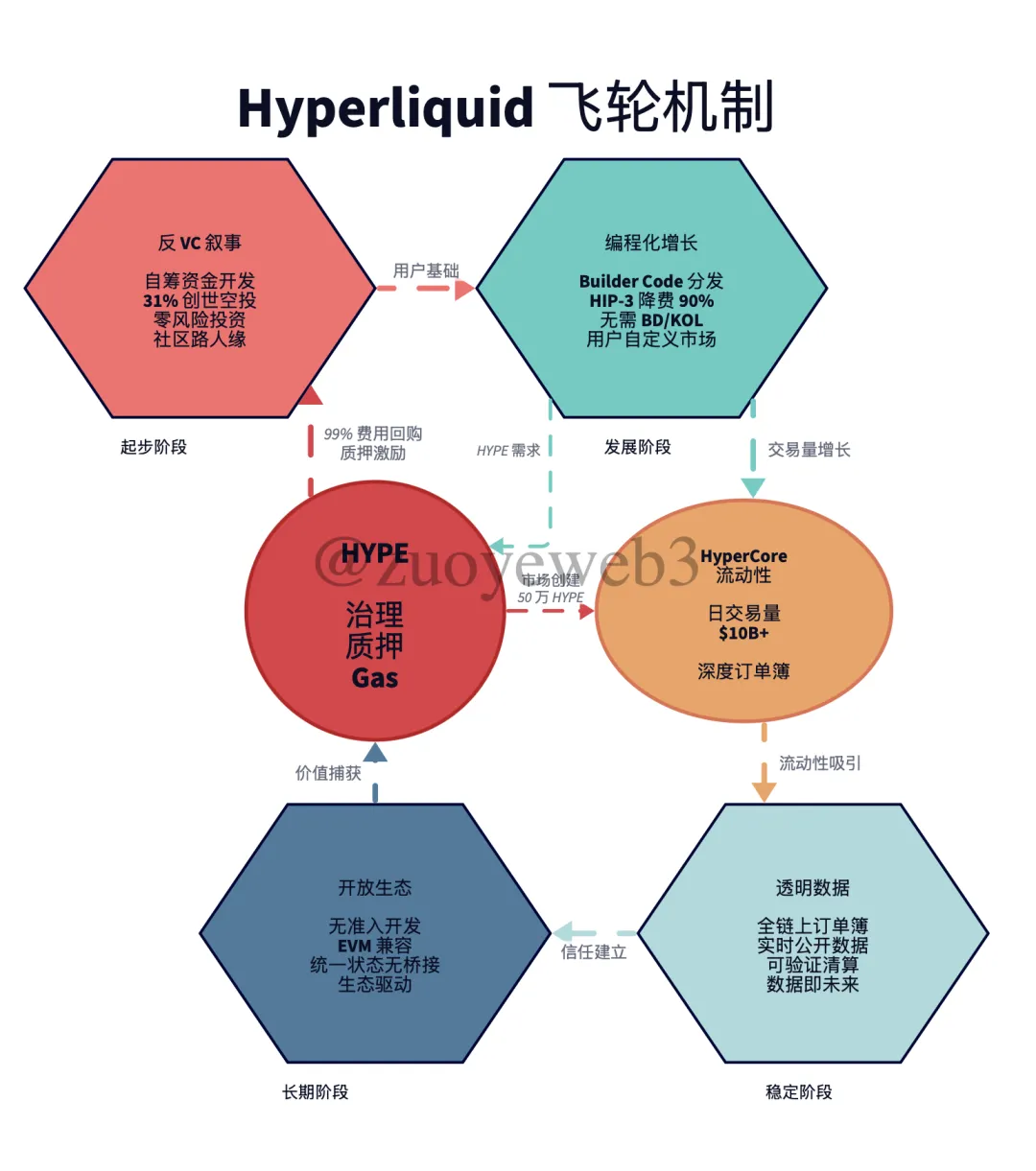Binance has launched an attack on Hyperliquid's OI and trading volume with Aster, while $JELLYJELLY and $POPCAT have consecutively targeted HLP, which is merely a minor ailment;
Despite the promising news of the booming HIP-3 growth mode, the rumored BLP (lending protocol), and $USDH actively staking 1 million $HYPE to become aligned quote assets, Hyperliquid has revealed its own cracks—HyperEVM ecosystem and $HYPE are not yet aligned.
Alignment is not complicated; under normal circumstances, the HyperEVM ecosystem consumes $HYPE, and $HYPE also supports the development of the HyperEVM ecosystem.
Currently, the situation is abnormal. The Hyperliquid Foundation's focus remains on the utilization of $HYPE in the HyperCore spot, contract, and HIP-3 markets, while the development of the HyperEVM ecosystem remains a second-class citizen.
Earlier, a third-party proposed the HIP-5 proposal, hoping to allocate some funds from the $HYPE buyback fund to support ecosystem project tokens, but it faced overall denial and skepticism from the community. This points to a harsh reality: the current price of $HYPE is entirely supported by the HyperCore market buybacks, with no surplus to support the HyperEVM ecosystem.
A Stone from Another Mountain: The Successes and Failures of Ethereum's Scaling
The shift to L2 Rollup has not satisfied ETH, and third-party sequencers are nearly absurd.
The development of a blockchain involves three main entities: the main token (BTC/ETH/HYPE), the foundation (DAO, spiritual leaders, companies), and ecosystem project parties.
Among them, the interaction model between the main token and ecosystem project parties determines the chain's future:
- Main token ⇔ Ecosystem: Two-way interaction is the healthiest; ecosystem development requires the main token, which empowers ecosystem projects. SOL currently does this best.
- Main token -> Ecosystem: The main token unidirectionally empowers the ecosystem; after the main token's TGE, it disperses, typical examples being Monad or Story.
- Ecosystem -> Main token: The main token drains the ecosystem projects, which are in a competitive and cooperative state with the main token.
The historical changes in the relationship between Ethereum, its DeFi projects, and L2 are the most direct and can reflect the current true state of HyperEVM and the possibilities for future breakthroughs.
According to research by 1kx, the top 20 DeFi protocols account for about 70% of on-chain revenue, but their valuations are far inferior to that of the underlying public chains. The theory of fat protocols still holds sway; people trust Uniswap and stablecoins on Ethereum more than standalone Hyperliquid and USDe.
Not to mention that Vitalik has long "disliked" DeFi but cannot live without it, ultimately awkwardly creating a low-risk DeFi theory. Many DeFi protocols have attempted to build their own portals, from dYdX V4 to MakerDAO's EndGame plan in 2023, with technology choices spanning Cosmos and Solana and other AltVM systems.
Then came Vitalik's public sell-off of $MKR. Beyond the interaction between the main token and the ecosystem, people have long underestimated the "official" legitimacy granted to public chains, especially the role of spiritual leaders.
Vitalik, representing the Ethereum Foundation (EF), has long allowed DeFi to run its course while focusing on metaphysical philosophical concepts. The clam and the snipe contend, and the fisherman benefits; the rise of the Solana DeFi ecosystem is not unrelated to this. Ultimately, Hyperliquid has entered the fray with a model of exchange + public chain, bringing public chain competition into a new phase.
The impact of Solana on Ethereum has led to widespread criticism of Vitalik and the EF. However, outside of DeFi, the gains and losses of L2 scaling are even more thought-provoking. The L2/Rollup route has not technically failed, but the diversion of L1 revenue has led ETH into a downward cycle.


Image Description: ETH's Dream: L2 Scaling -> L1 Scaling
Image Source: @zuoyeweb3
When Ethereum L1 faced the demand for scaling after the DeFi explosion, Vitalik designated a Rollup-centered scaling route and gambled on the long-term application value of ZK, guiding the industry, capital, and talent towards a FOMO sentiment for ZK Rollup. From 2020 to 2024, this created countless wealth effects or tragedies.
However, one point remains: DeFi is a real product aimed at the C-end. The continuously launched L2 essentially consumes Ethereum L1's infrastructure resources, thereby splitting ETH's value capture ability. The end of L2/Rollup is expected in 2024, with a return to the L1 Scaling route in 2025.
After four years away, it returns to being L1-centric.


Image Description: Speeding up and reducing costs harms its own revenue
Image Source: @1kxnetwork
On a technical level, ZK and L2/Rollup have indeed significantly alleviated the burden on L1. Speeding up and reducing costs has benefited participants, including ordinary users. However, outside the competitive and cooperative relationship of public chain > DeFi (applications), an economic complexity has been added, creating a complicated triangle of public chain > L2 > applications, ultimately resulting in a three-way loss situation.
Ethereum's income from L2 has decreased, L2's excessive wealth effects are dispersed, and applications are constantly expanding, leading to a diversion of L2's focus.
Ultimately, Hyperliquid concludes the dispute with the unified stance of "public chain is application, application is transaction," and Vitalik lowers his proud head to reorganize the EF (Ethereum Foundation) and re-embrace user experience.
In the process of shifting from L2 to L1, at a certain point in time, technical choices, such as Scroll's emphasis on four types of ZK EVMs and Espresso's bet on decentralized sequencers for L2, have ultimately been falsified. Recently, Brevis has gained attention as Vitalik re-emphasizes the importance of ZK for privacy, which is no longer closely related to Rollup.
The fate of a project must consider both its own efforts and the historical process.
Amidst the dazzling array of flowers, Hyperliquid, moving from one victory to another, has once again encountered Ethereum's dilemma. How should it handle the relationship between the main token and the ecosystem?
Throwing a Brick to Attract Jade: The Alignment Choices of HyperEVM
BSC is an appendage of Binance; what exactly is HyperEVM to Hyperliquid? The team has not figured it out.
In the article "Creating Waves with HyperEVM," the unique development path of Hyperliquid was introduced: first creating a controllable HyperCore, then an open HyperEVM, while linking the two with $HYPE.
Recent developments show that the Hyperliquid Foundation insists on empowering $HYPE as the center, maintaining HyperCore as the main body, and developing a token economics model for various HyperEVM ecosystems.
This raises the core concern of this article: how should HyperEVM carve out its unique development path?
The BSC ecosystem is an appendage of Binance's main site and $BNB, with its PancakeSwap and ListaDAO swaying with Binance's will, so there is no competitive relationship between BNB and BNB Chain.
Even Ethereum, strong as it is, cannot maintain a long-term balance between ETH and the free prosperity of its ecosystem. In comparison, the existing problems of Hyperliquid are detailed as follows:
- There is no established collaborative relationship between HyperEVM and HyperCore, leaving HyperEVM in an awkward position.
- $HYPE itself is the only concern of the Hyperliquid Foundation, leaving ecosystem project parties somewhat at a loss.
Before answering the question, let's take a look at the current state of HyperEVM. It is very clear that the HyperEVM ecosystem projects are not keeping pace with the Hyperliquid team's thinking.


Image Description: HyperEVM Stablecoin Market Share
Image Source: @AIC_Hugo
The USDH team's election has triggered FOMO among many stablecoin teams, but the existing stablecoin project parties in HyperEVM do not have significant advantages. BLP may also face potential conflicts of interest with existing lending protocols, and the most obvious HIP-5 proposal event has garnered almost no support for empowering ecosystem projects with the HYPE token.
$ATOM is the heartache of the Cosmos team, while $HYPE is the mirage for ecosystem project parties; no matter how much is done, it is still consumable.
A classic question arises for HyperEVM ecosystem project parties: What if Hyperliquid succeeds?


Image Description: Hyperliquid Flywheel
Image Source: @zuoyeweb3
Looking at the Hyperliquid team's consistent approach, they are very adept at making moves during industry crises to build their own antifragility. During industry downturns, not only are the costs of attracting new users low, but they also reverse market their robustness, gradually fostering a tight community consensus around Hyperliquid.
- In the initial stage, the anti-VC narrative emphasized self-funding for market making and entrepreneurship. Although they still allied with market makers and VCs for token purchases, they garnered significant goodwill from the public, attracting early seed users.
- In the development stage, the marketing strategy was not about recruiting business development to attract KOLs for commissions, but rather programming it (Builder Code/HIP-3 Growth Mode), allowing users to fully customize their experience.
- In the stabilization stage, maximizing transparent data is also Hyperliquid's latest contribution to blockchain beyond decentralization (with few nodes and centralized governance by company will), allowing transparent data to represent the future on-chain.
- In the long-term stage, the openness of HyperEVM should not be based on human trust to build the on-chain ecosystem, but rather drive ecosystem development without entry barriers.
The issue lies in the long-term vision. The interests of the Hyperliquid Foundation and $HYPE are completely aligned, but to some extent, HyperEVM has a cautious inclination to prioritize the development of its own token and ecosystem. This is understandable, as the on-chain ecosystem is inherently a game of liquidity for growth.
The governance mechanism has not kept pace with the real demands of technological innovation. From Satoshi's departure to Vitalik's admiration and abandonment of DAOs, and then to the foundation model, public chain governance is still undergoing constant experimentation.
In a sense, the Vault Curator also embodies the contradiction between technology and mechanism, continuously absorbing the realities of governance systems into the on-chain realm. Lawyers + executives + business development; the emergence of large on-chain companies is even more abstract than those in Silicon Valley and Zhongguancun.
The Hyperliquid team is at least closer to the technical characteristics of blockchain in terms of "everything being programmable." On-chain is inherently trustless, and there is no need to laboriously establish trust models. However, this set of principles still requires additional impetus on HyperCore, such as the management of HLP, which is likely to require manual intervention during crises.
At least at this stage, HyperEVM has not truly achieved "no entry barriers" in governance mechanisms and liquidity. This does not mean that Hyperliquid is still imposing technical restrictions, but rather that legitimacy has not yet been fully opened to the entire community.
We will witness the co-evolution of HyperEVM and $HYPE in the impending bear market, or we may see Hyperliquid devolve into a Perp DEX.
Conclusion
Our ETH, Hyperliquid's problem.
Ethereum's resilience is indeed robust, having undergone the transition from PoW to PoS and from L2 Scaling to L1 Scaling, as well as facing the impacts of Solana in the DeFi space and Hyperliquid in the DEX space, yet it still maintains an unshakable market position.
Moreover, $ETH has already navigated through bull and bear cycles, but $HYPE has not yet faced the true test of a bear market. Sentiment is a precious consensus, and there is little time left for the alignment of $HYPE and HyperEVM.
免责声明:本文章仅代表作者个人观点,不代表本平台的立场和观点。本文章仅供信息分享,不构成对任何人的任何投资建议。用户与作者之间的任何争议,与本平台无关。如网页中刊载的文章或图片涉及侵权,请提供相关的权利证明和身份证明发送邮件到support@aicoin.com,本平台相关工作人员将会进行核查。




